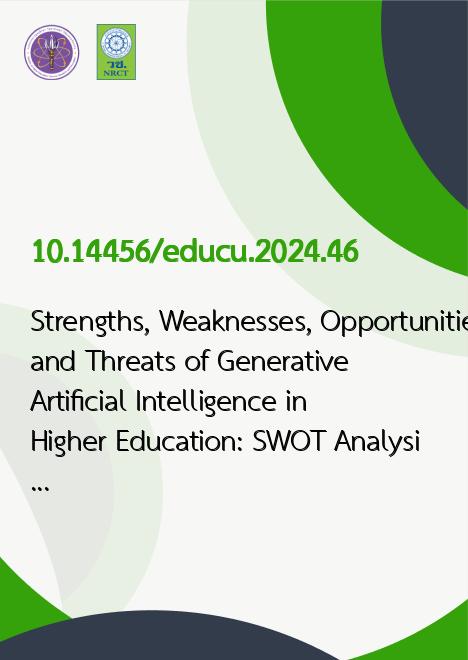
|
Strengths, Weaknesses, Opportunities and Threats of Generative Artificial Intelligence in Higher Education: SWOT Analysis |
|---|---|
| รหัสดีโอไอ | |
| Creator | Netchanok Treerayapiwat |
| Title | Strengths, Weaknesses, Opportunities and Threats of Generative Artificial Intelligence in Higher Education: SWOT Analysis |
| Contributor | Sarinporn Chaivisit |
| Publisher | Centre for Education Innovation, Print and Online Media |
| Publication Year | 2567 |
| Journal Title | Journal of Education Studies, Chulalongkorn University |
| Journal Vol. | 52 |
| Journal No. | 3 |
| Page no. | EDUCU5203016(17pages) |
| Keyword | generative artificial intelligence, GenAI, AI in education, SWOT analysis, higher education |
| URL Website | https://so02.tci-thaijo.org/index.php/EDUCU |
| Website title | Journal of Education Studies, Chulalongkorn University |
| ISSN | 2651-2017 (Online) |
| Abstract | Generative artificial intelligence has rapidly spread to the public all over the world, reaching users in various industries, including education. The application of generative artificial intelligence in education presents both benefits and risks that impact higher education. Consequently, a thorough understanding and empirical data on generative artificial intelligence in education are essential. This study was therefore conducted utilizing the framework of SWOT analysis by searching, collecting, and examining relevant literature. The strengths, weaknesses, opportunities, and threats of generative artificial intelligence in higher education were analyzed and identified. The identified positive outcomes include: (1) strengths, namely the creation of interactive messages in natural language; support for multiple languages; instant replies and direct answers to questions; ease of access for beginners; and the capacity to generate diverse content; and (2) opportunities, namely widespread public accessibility; personalized learning support; assistance with homework; specialized tutoring and exam preparation; support for writing and brainstorming; facilitation of research and information retrieval; and aid in producing teaching materials and exams. Conversely, the identified negative outcomes include: (1) weaknesses, namely ambiguity and lack of explainability; system bias; incorrect or unavailable information in response to commands; privacy and data security issues; and ethical and legal risks; and (2) threats, namely the necessity to develop a generative artificial intelligence policy for education; modifications to teaching and assessment methods; changes to educational management; addressing the issue of declining learning skills among students; ensuring equal access to generative artificial intelligence; and combating the threat of academic dishonesty. These findings will be beneficial to students, teachers, educators, educational technology experts, and policymakers, as they provide a comprehensive analysis of both the benefits and threats of generative artificial intelligence in education. This analysis can inform the development of strategies for integrating generative artificial intelligence into higher education in the future. |